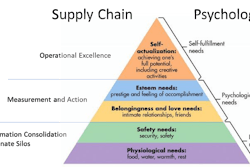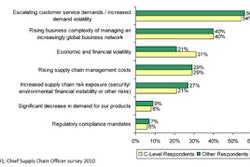By William Atkinson
While most companies focus efforts on improving supply chain efficiency by looking at the supply chain process itself, a few realize that other departments can have an impact on efficiency and speed. One of these departments is Quality, which is tasked with inspecting incoming raw materials, in-process work and final product before it is shipped. If there is a way to help the Quality department get its job done faster, then, by definition, the operations process can move along faster, thus reducing time in the supply chain.
One company that realizes the value of quality and operations working together is Kao Worldwide, which used to be the Andrew Jergens Company (now Jergens). The company manufactures personal care products such as hair care products, skin care products, and soap products for brands like Jergens, Biore, John Freda and others.
"About 10 years ago, I started to get tired of listening to the people in our planning group complain about how long it took to get micro results," says Mark Entrup, USA corporate microbiologist for Kao, based in Cincinnati. (Micro results come from the lab work that is done to test for contaminants in Kao's products before they are released for shipment.)
In looking around for a solution that could speed up the lab process, and thus the quality control process, Entrup focused on a company called Celsis, which manufactures microbial detection equipment for biological testing. The technology uses a luminometer, combined with the recommended reagents, to test consumer-bound products for microbial contamination, such as bacteria, yeasts and molds, in as little as 24 hours. It offers the fastest time to confirm the absence of microbial contamination, even slow-growing molds.
Quality's Link to Efficiency
Celsis's Advance system is designed to help customers improve cash flow and reduce working capital requirements, while ensuring quality and increased responsiveness throughout the supply chain. "Even before coming here, I was always interested in working with rapid microbiology methods," Entrup says. "When I heard about Celsis, I became interested. We ended up purchasing the Celsis Advance system in 2000."
Celsis serves a number of different industries. Personal care was one of the early adopters because of the large consumer product volumes they have, as well as having an early understanding of the value of saving time in the supply chain. In fact, a number of large consumer product manufacturers have been Celsis customers for 15 years or more. Many of them mandate Celsis technology in their production facilities. Some even mandate it for their contract manufacturers and their packagers.
There also is a new interest in the technology as a result of two phenomena. One is related to recent economic pressures that have pushed companies to seek ways to streamline their supply chains even more. The other is related to what seems to be an increase in contaminated products being manufactured and even released. By being able to identify contaminated products faster, companies are able to respond faster to contaminated batches and thus prevent more from being manufactured. They may also be able to prevent contaminated products from getting into the market in the first place.
The Celsis technology tests for bacteria, yeast and mold in raw materials when they first arrive, in in-process work and in finished product. In the past, such testing usually took three to five days. As noted earlier, Celsis can provide results in as little as 24 hours. Customers that use the technology for all three phases – incoming raw materials, in-process work and finished products – can thus save a week or more, which translates into a significant improvement in supply chain efficiency.
Six- to Nine-month ROI
To truly benefit from the technology, Quality and Operations need to work together. Once the technology is in place, the Quality department likes the results, and the Operations department appreciates the speed. However, unless and until both departments sit down and discuss the mutual benefits beforehand, it can be difficult for either department to want to make the effort to seek funding to purchase the technology.
To help companies with this process, Celsis has worked with management consulting firm Arthur D. Little to create a Value Creation Model (VCM), which helps to quantify the financial value of implementing Celsis technology at an individual plant. The VCM shows the amount of time it would take to realize a return on investment, as well as a five-year net present value. On average, customers that have implemented the technology see an ROI within six to nine months, as well as a $500,000 five-year net present value.
The technology uses a simple and familiar protocol, and only a single enrichment is needed for detection. The testing is also non-destructive, allowing for further testing.
Kao uses the product for final product QC testing of its hair care, skin care and soap products. "One reason we selected Celsis over competitors is that it provides pass-fail results, and we can set it up to define what the pass-fail will be," notes Entrup. "I also liked the science behind Celsis, and it was already very well-proven at the time."
However, when encouraging Kao's initial adoption of Celsis several years ago, one challenge for Entrup was trying to assign tangible dollar amounts to the savings that it would provide to the company. "We didn't have a good feel at the time for what kinds of savings would be involved," he notes. As mentioned earlier, Celsis now has computations available for this in the form of the VCM.
Added Benefits
"Using Celsis, we now get results in one to two days, rather than three or four days," Entrup notes. In addition, if there is a positive result (meaning that the sample did test positive for bacteria, yeast or mold), it allows Kao to re-test quicker and obtain re-test results quicker. "Since the technology allows us to get micro results in half the time, we are able to release products and ship products pretty much as needed," he continues. "This has also reduced our warehouse space significantly. That is, instead of having to produce and then stockpile, the technology allows us to produce as orders require."
For Kao, other results have included a reduction in the time it takes personnel engaged in lab testing. "This allows more time for them to do other things in the micro labs that they weren't able to do before," Entrup explains. "It also lets our quality services group, which is responsible for finished product testing, to get their job done quicker."
While the technology does have benefits, it does need to be monitored. "One important key is to follow the maintenance and upkeep schedule that Celsis has prescribed," emphasizes Entrup. "The people who are using the machine really need to understand what it is doing. They can't just walk through and get results. They have to really understand the machine. If they don't, they won't be able to troubleshoot or maintain it properly."
The technology is working so well in Cincinnati that, in the near future, some representatives from Kao's parent company in Japan will be visiting the Cincinnati facility to discuss the potential for the technology to provide some "preservative challenge" testing. This testing challenges products to determine if they have enough preservative in them.
Meanwhile, the economy has prompted other companies to begin looking at following in Kao's footsteps by linking Quality and Operations, according to Lindsay Tjepkema, marketing and communications manager with Celsis. By leveraging the kind of solution offered by her company, "your safety stock is less, you're throwing away less products, and the potential damage to your company and your brand is greatly reduced," Tjepkema says. "In this time, with the economy being the way that it is, it's all the more important to make sure that you're doing things right, and Celsis really helps you do that.













